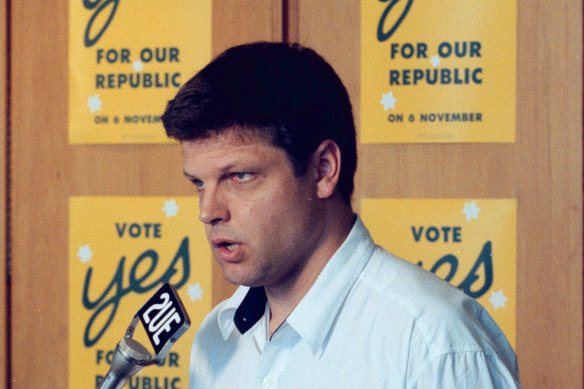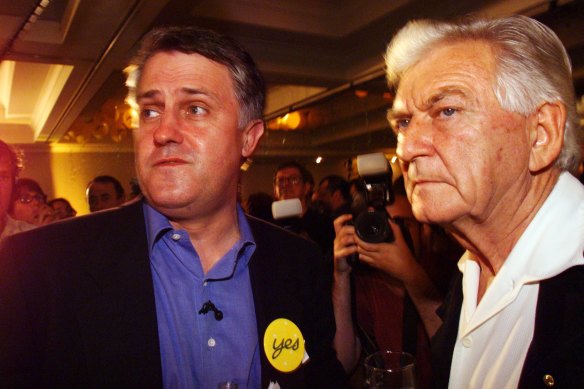This was published 3 years ago
Opinion
What we got wrong in 1999 and how to secure a republic this time
Greg Barns SC
BarristerThe appointment by Prime Minister Anthony Albanese of Matt Thistlethwaite as assistant minister for the republic is the most significant development in the campaign for an Australian head of state in more than two decades. It shows a commitment to ensuring Australians get another chance to change the constitution so we finally cut the last of the apron strings that attaches us to our former colonial master.
But before anyone gets too excited it is critical that the lessons of the failed republic referendum campaign in 1999 are learnt and mistakes not repeated. That campaign saw about 45 per cent of Australians voting for a head of state elected by a two-thirds majority of the federal parliament. It was defeated by a combination of factors, all of which remain relevant today, except for the important fact that the personal affection for Queen Elizabeth will be much less of a factor in the next referendum.

Greg Barnes in 1999, when he was campaign director for the Yes vote in the republic referendum.Credit: Peter Rae
I was national campaign director of the Yes campaign in 1999, led by Malcolm Turnbull, who would go on to become prime minister. I saw up close how difficult it is for a referendum to pass in this nation. Only eight of 44 of attempts to change the constitution have been successful since 1901. It is a hard ask because to win you need a national majority of voters and a majority of voters in at least four of the six states.
But in 1999 a major hurdle for our case was the vehement opposition of the then prime minister John Howard. He had been stuck with the commitment of the Liberal Party, when it won office in 1996, to hold a referendum on an Australian head of state, something pushed by Howard’s predecessor Paul Keating. Howard campaigned against a republic, as did many of his ministers.
A group headed by former Liberal Party director Andrew Robb, which gathered conservative voices in support of a republic, the contributions of other members of Howard’s cabinet, and former Liberal prime minister Malcolm Fraser was not enough to counter the Howard influence.

Facing the grim news: Bob Hawke and Malcolm Turnbull digest the result of the republic referendum in 1999.Credit: Steve Lunam
This time around it is likely to be Albanese who pushes the republic cause, which should assist the yes case. But let’s not underestimate opposition from the opposition, if only to inflict political damage on the prime minister.
But perhaps the most potent elements of the campaign in 1999 to keep the British monarchy in Australia were, first, division among republicans, second, the line that the republic was a matter for “elites”, and, most damaging of all in my view, the idea that what was proposed was a “politicians’ republic”.
The division was caused by those republicans who supported a president directly elected by the people. This group included former federal Independent MPs Ted Mack and Phil Cleary. They joined the Australians for a Constitutional Monarchy group to oppose the parliamentary election model. Division is death in politics, as they say, and in this case it was true. Cleary, Mack and others were able to argue that the model on offer was not “democratic” and they reflected the mood in the electorate, which was opposed to giving politicians more power.
Getting the model of constitutional change right this time means building a consensus to minimise the chances of a repeat of those highly damaging divisions. It may be that a two-step approach is required: first, an indicative plebiscite putting models to the electorate, and then putting the one most favoured to a referendum.
Former West Australian premier and Australian Republic Movement chairman Geoff Gallop has argued for a citizens’ assembly. This would involve a genuine cross-section of Australians informing themselves and then deliberating on the model for the referendum. This mechanism, known as “deliberative democracy”, has been successfully used in Ireland, the United States and Canada to ensure the community gets a real say in nation-changing proposals.
Then there is the issue of how to run a campaign for change. In 1999, there was criticism that the Yes campaign relied too heavily on celebrities and former politicians to push its case. It is not a criticism I buy because the research at the time suggested the most relevant factors in hesitancy about a republic were, rather, the potent scare campaign about what the change would mean and the division I’ve discussed.
But it is critical that the ARM and its allies run a campaign that embraces Australians across the board. One way to achieve that is to link the issue of a republic to Indigenous constitutional recognition. It is incongruous to change the constitution to recognise the ancient and ongoing link of Indigenous Australians to this land while maintaining a position that no Australian can ever be head of state. By linking the two, there might be a greater level of engagement in the community, given that many Australians feel real passion for Indigenous recognition.
As the Queen’s man in Australia, Governor-General David Hurley said last weekend that when the much-loved Queen abdicates or dies, this will represent a natural step-off point for Australians to have a “discussion” about cutting ties with the British monarchy. But there is much planning to be done before that happens, and one should not underestimate the determination of opponents of an Australian head of state.
Learning the lessons of the past is generally desirable, and in this case it is mandatory.
Greg Barns SC was the national campaign director of the 1999 referendum for the republic Yes case. He was the chairman of the Australian Republic Movement from 2000 to 2002 and co author of An Australian Republic (Scribe 2006).